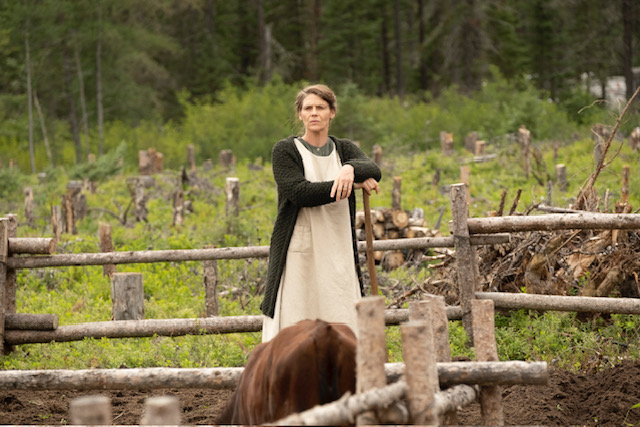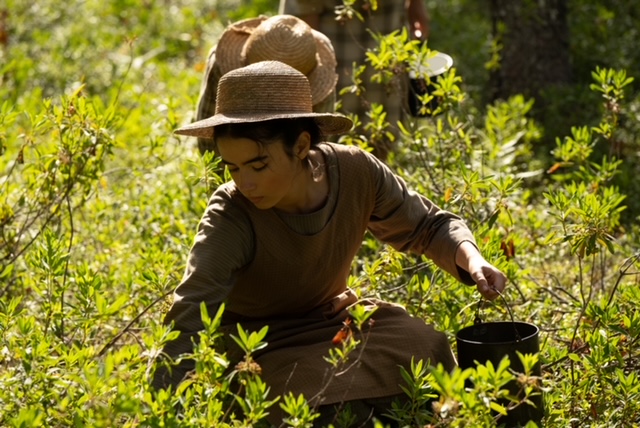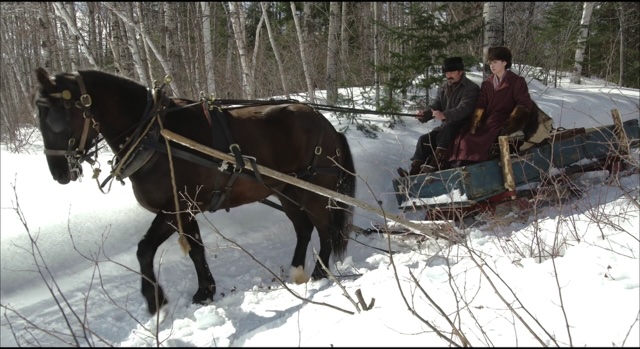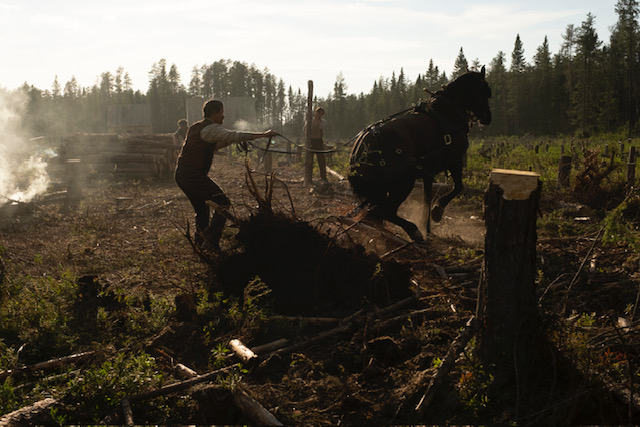Maria Chapdelaine: More than a heroine, she’s the symbol of a way of life
“…to see my men make a beautiful piece of land…A beautiful piece of land that has been full of wood, stumps and roots and to see a fortnight later it to be as bare as a hand, ready for the plough, I’m sure there can be nothing in the world more beautiful and lovable than that.” (1)

Louis Hémon was a French journalist and writer, born at Brest in 1880 and experienced Parisian art and literature of the late 19th century. It was a genre of literature, offering a realistic representation of the world and often focused on the working members of society and their hardships. Hémon traveled to Canada in search of a novel that portrayed the like-lives of the French Canadiens and found it at Péribonka, located on the isolated eastern shores of Lac Saint-Jean. Over a hundred years later this remote village is still one of the smallest in Québec with less than 500 inhabitants. Hémon spent 6 months observing the daily life of the parishioners of Saint-Amedee de Péribonka and took special note of the local dialect and lexicons that he found to be like those of his ancestral home of Britany.
Hémon’s chosen heroine, Maria Chapdelaine, is secondary to the story of the life of Québecois settlers of the region. Evan though a fictional character she gave her name to an administrative county of northern Québec. The heroine’s choice of three suiters and their differing aspirations exemplifies the same decisions that confronted the paysans of Québec of that time; whether to remain on the farm or emigrate. Hémon wrote of the eternal misunderstanding of the two races: the pioneers and the sedentary. C’était l’éternel malentendu des deux races: les pionniers et les sédentaires. (2) This difference is well exemplified by the two Jesuits, François de Crespieul and Charles Albanel, who settled in the area in 1673. Crespieul remained in this mission country for 30 years. Albanel’s explorations, however, took him to Hudson Bay and Lake Superior. He died in Sault-Sainte-Marie in 1696. (3)
I wrote about the Québecois migration to Chicago in this publication: See https://frenchquartermag.com/chicagos-19th-century-little-quebec/ and was intrigued by a novel, based on a case study of the rural life of Québec during the same era.
Maria Chapdelaine is actually two books in one. The dialogue is pure Québécois but the overview is the French of the author’s time and education. In fact, the book is frequently referenced as examples of Québecois vocabulary by Centre National de Resources Textuelles et Lexiales, Nancy Université. At first, I found this confusing, but quickly adjusted to the shift from French of the ‘’ Academy’’ and the language common in rural Québec. I confess to be at best, an intermediate of French and as habit create a glossary of terms and vocabulary as I read. Reading Maria Chapdelaine, I advanced no more than one paragraphed before being confronted with a grammar lesson centered around the verb, Gésir. In the end I had created a glossary of 30 pages of terms in the order that I confronted them. Louis Hémon employs a wealth of synonyms in a reinforcing effort to express a thought. I found Louis Hémon’s style of describing the customs and habits of his subjects to be reminiscent of modern day Anthony Bourdain, and can image Bourdain having made this very observation of Hémon’s :
“Les tutoyant du tutoiement facile du pays de Québec” Informality is accepted amounst those on first name basis, but family discipline dictated that children address their parents in formal tones, vouvoyer.
Hémon explored the risks of the vagabonds and the sacrifices of sédentaires, their remoteness and solitude. The Church often inaccessible, is omnipresent in their daily lives because: obeyance of the laws of nature and the Church are woven into the same cloth. A family ritual of gathering blueberries in the forest during summer is as pious as counting prayers on the rosary at Christmas Eve while being wintered in and unable to venture to Church.

Chapter XII encapsulates the theme of cultural divide. A visit to Honfleur, eight miles and and a two- and half-hour sleigh ride a way was still a way of life apart. The visit reveals how isolated the paysans were. Saint Monique de Honfleur today has less than 900 inhabitants but in 1910 it was a small village with walks and paved streets. It was a planned residential and recreational community, with surveyed lots on which speculators could invest. (4) It would have brought economic and cultural diversity to the region. Speculators came from as far away as France, Ontario and the United States. Economic diversity is always accompanied by cultural friction. On arriving in Honfleur, the Chapdelaine family immediately discovered Their appearance would have been enough to distinguish them from the other inhabitants of the village; but as soon as they spoke, the gap seemed to widen still further, and the words that came out of their mouths sounded like words from a foreigner. (5) At the end of the evening, they returned to their homes with the affirmation that a life of subsistence on the farm was better than relying on the discards of the rich.

What Hémon chose not to write about was the interventions that the Québec government was initiating to change the lives of the people of this region. There was a wood pulp factory in Péribonka in 1910, during Hémon’s visit there. That very same year the Québec government banned exportation to the United States pulp made from wood cut on public lands. This action was the catalyst for the development the paper industry throughout Québec. By 1929 Chicoutimi would become a major North American paper producing area and with the advent of the electricity industry a major manufacturing region. Hémon was more interested in the romanticism of a disappearing way of life than that of the belated industrialization of the area. (6)

There have been three Québecois film productions of Maria Chapdelaine and the most recent production is excellent cinematography that captures Hémon’s overviews on camera and leaving only the Quebecois dialogue to be digested. With the aid of coordinated subtitles in French, the dialogue of the novel is easy to follow. Hémon describes the labor of the paysans as: from four in the morning to nine in the evening , he set about whatever task needed and brought to it a fierce frenzy that never wore off… and proceeds to write of the labors in the field. This is what Sébastien Pilote has captured in his film. Viewers imagine their backs aching and sweat profusely as they experience ‘’faire de la terre’’. Viewers sense the hunger that grows over the morning’s work and the satiating of the same at the mid-day meal. (7) I have crossed refenced Hémon’s descriptive sections of the book with the scenes captured by film director, Sébastian Pilote in his 2021 film Maria Chapdelaine. Pilote relied heavily on Louis Hémon words as screen direction, and the result is a 2.5-hour film that leave the viewer wanting more. Pilote consolidated the sixteen chapters of Hémon’s book into five, but nothing is lost in the production of the film. My reference document and my glossary are available on request. Both the book and the film are excellent tools for enriching vocabulary.
(1). Hémon, Louis. Maria Chapdelaine . Editions Caractere Inc. 2014 P 48
(2). Ibid : P. 38
(4). https://ville.ste-monique.qc.ca/historique
(5). Hémon, Louis. Maria Chapdeplaine. Editions Caractere Inc. 2014 P 38
(6). Hébert, Jean-François ; LA PULPERIE DE CHICOUTIMI. UN SIÈCLE D’HISTOIRE, pp. 11-20. Chicoutimi : Musée de La Pulperie de Chicoutimi : Coutu, Guy “L’industrialisation du Saguenay—Lac-Saint-Jean,1896-1929.”
(7). Maria Chapdelaine, Unfilm de Sébastien Pilote : 2021, MK2-Mile End, Sphere-Media Proctions
Header Photo Credit: Laurence Grandbois-Bernard





















Fantastic read! This article does an excellent job of breaking down what smart homes are and how they’re transforming modern…